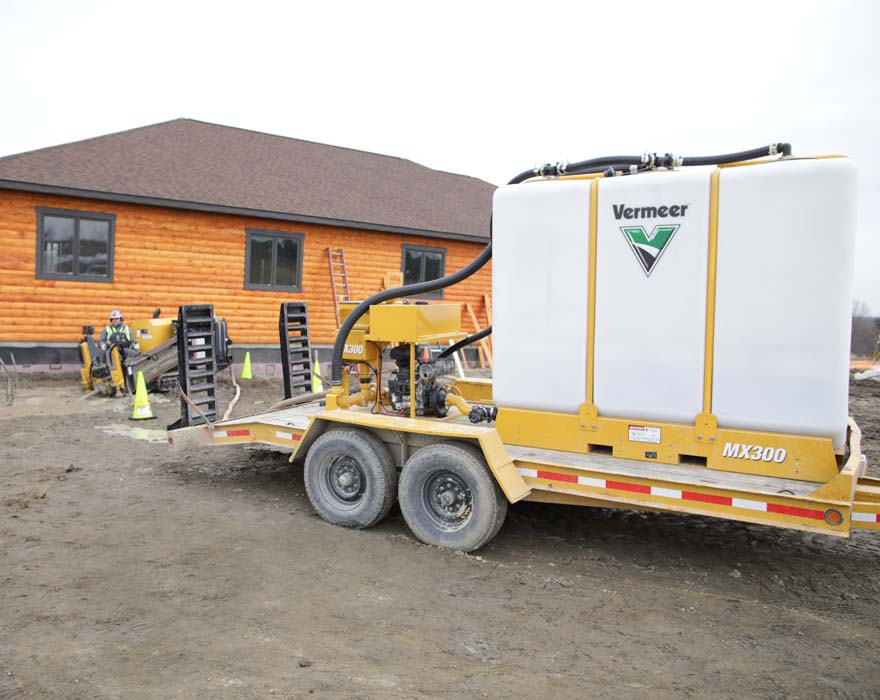Many horizontal directional drill (HDD) operators have heard a story or two about someone completing a massive bore while drilling dry or using only water. Those stories may be true, but there can be many drawbacks to boring this way. Drilling dry or using water alone can slow drilling production, put a bore at risk of failure and lead to premature tooling wear.
Drilling fluid or mud is a crucial ingredient to maximize an HDD crew’s efficiency and should be used whenever possible. It helps provide lubrication and cools downhole tooling and electronics, helps maintain the integrity of the bore path and flushes drill cuttings. Here’s an overview of a few of the issues you may encounter without using mud.
Drilling dry
“In ideal ground conditions, performing short, small-diameter bores without any fluid is possible,” explained Tod Michael, product manager for the trenchless core products at Vermeer. “However, even in these conditions, drilling dry will typically require rotation speeds and production rates to slow. There is also a lot more friction downhole, which can cause tooling to heat up. The extra heat can potentially damage the drill head and sonde.”
Over time, the lack of drilling fluid can lead to premature wear to the drilling head and drill pipe. It can also put unnecessary strain on the product being pulled back. “Just using a little bit of drilling fluid in ideal ground conditions can go a long way to help keep up production rates and help contractors maximize the life of their tooling,” added Michael.
Water only
Probably more common than drilling dry, contractors will skip using bentonite or polymer and only run water through the drill string. Michael said this is a better option than using nothing at all, but there can be risks involved with this approach. “Crews doing just a pilot bore and then pulling back small-diameter product can get by with this in loamy clay soils, since those situations are a lot more forgiving,” he explained. “However, using drilling fluid with the right additive can help limit the risk of the hole collapsing.”
Water offers very little lubrication, which means there is more drag and friction on drill rods and the drill head. “Adding some type of additive to the water will help reduce the risk of premature tooling wear,” Michael said.
Also, water lacks the viscosity to maintain hole integrity or float drill cuttings out of the hole.
Mix it up
There are numerous benefits to using drilling fluid with every bore, but to get the maximum benefit from the additives, it should be adequately mixed. “Whether contractors are buying bags of bentonite or have made the switch to liquid drilling additives in pouches, using a mixing system is crucial,” said Michael. “With powders, you can see if an additive hasn’t been properly mixed. However, with the newest prepackaged liquid concentrate additives, sometimes people think they can pour it into the water tank with minimal stirring. Proper mixing and testing of your fluids should still be done for the best results.”
To help with the mixing process, Vermeer offers several mix systems, appropriately sized for the directional drill your crew is running. The latest addition to the line is the Vermeer MX300 mixing system, and it features a redesigned, slim rectangular profile tank and a power unit that can be paired with up to two tanks at one time to help decrease the time spent refilling fluid tanks.
To drill as efficiently as possible and get the efficient performance from your downhole tooling, use drilling fluids. Also, if you need a little help educating your team about the proper ways to mix drilling fluids, check out the article “Making Sense of HDD Drilling Fluids.”
For more information about the Vermeer MX300 mixing system, talk to your local Vermeer dealer.
Vermeer Corporation reserves the right to make changes in product engineering, design and specifications; add improvements; or
discontinue manufacturing or distribution at any time without notice or obligation. Equipment shown is for illustrative purposes only and may display optional accessories or components specific to their global region. Please contact your local Vermeer dealer for more information on machine specifications.
Vermeer and the Vermeer logo are trademarks of Vermeer Manufacturing Company in the U.S. and/or other countries.
© 2019 Vermeer Corporation. All Rights Reserved.
